Tilburg University: BEPS, Hybrid Entities, and Interest Deductions
VerifiedAdded on 2022/08/13
|18
|3435
|15
Report
AI Summary
This report, authored by Nikolaos Broulias, investigates the implications of Base Erosion and Profit Shifting (BEPS) actions on hybrid entities and interest deductions within the context of international business taxation. The research focuses on the OECD's initiatives to combat tax avoidance, specifically examining how hybrid structures are utilized to exploit mismatches in tax regulations, potentially leading to double deductions of interest payments. The report delves into the definition of hybrid entities and hybrid mismatches, analyzing the application of BEPS actions, particularly Action 2 and Action 4, and their impact on financial accounts based on IFRS. It also explores the social impacts of related rulings, references case law and legislation, and discusses potential amendments to BEPS guidelines. The study highlights the complexities of international tax planning, emphasizing the need for countries to collaborate to prevent tax evasion and ensure fair revenue distribution. The report concludes with an assessment of the effectiveness of BEPS actions in addressing hybrid entity structures and the consequences of these actions on financial accounting.

Business Taxation and Decision-Making Processes
Paraphrase This Document
Need a fresh take? Get an instant paraphrase of this document with our AI Paraphraser
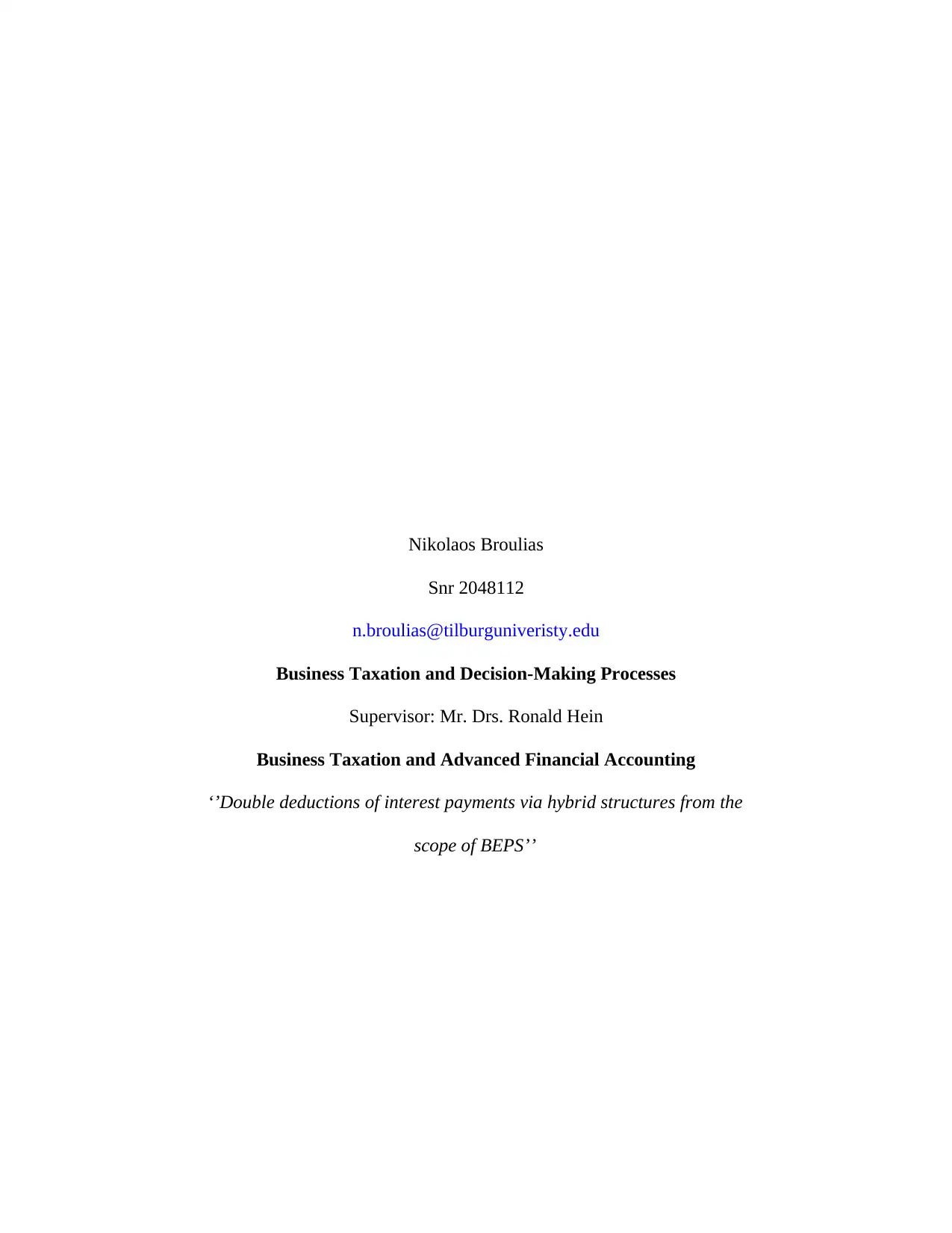
Nikolaos Broulias
Snr 2048112
n.broulias@tilburguniveristy.edu
Business Taxation and Decision-Making Processes
Supervisor: Mr. Drs. Ronald Hein
Business Taxation and Advanced Financial Accounting
‘’Double deductions of interest payments via hybrid structures from the
scope of BEPS’’
Snr 2048112
n.broulias@tilburguniveristy.edu
Business Taxation and Decision-Making Processes
Supervisor: Mr. Drs. Ronald Hein
Business Taxation and Advanced Financial Accounting
‘’Double deductions of interest payments via hybrid structures from the
scope of BEPS’’
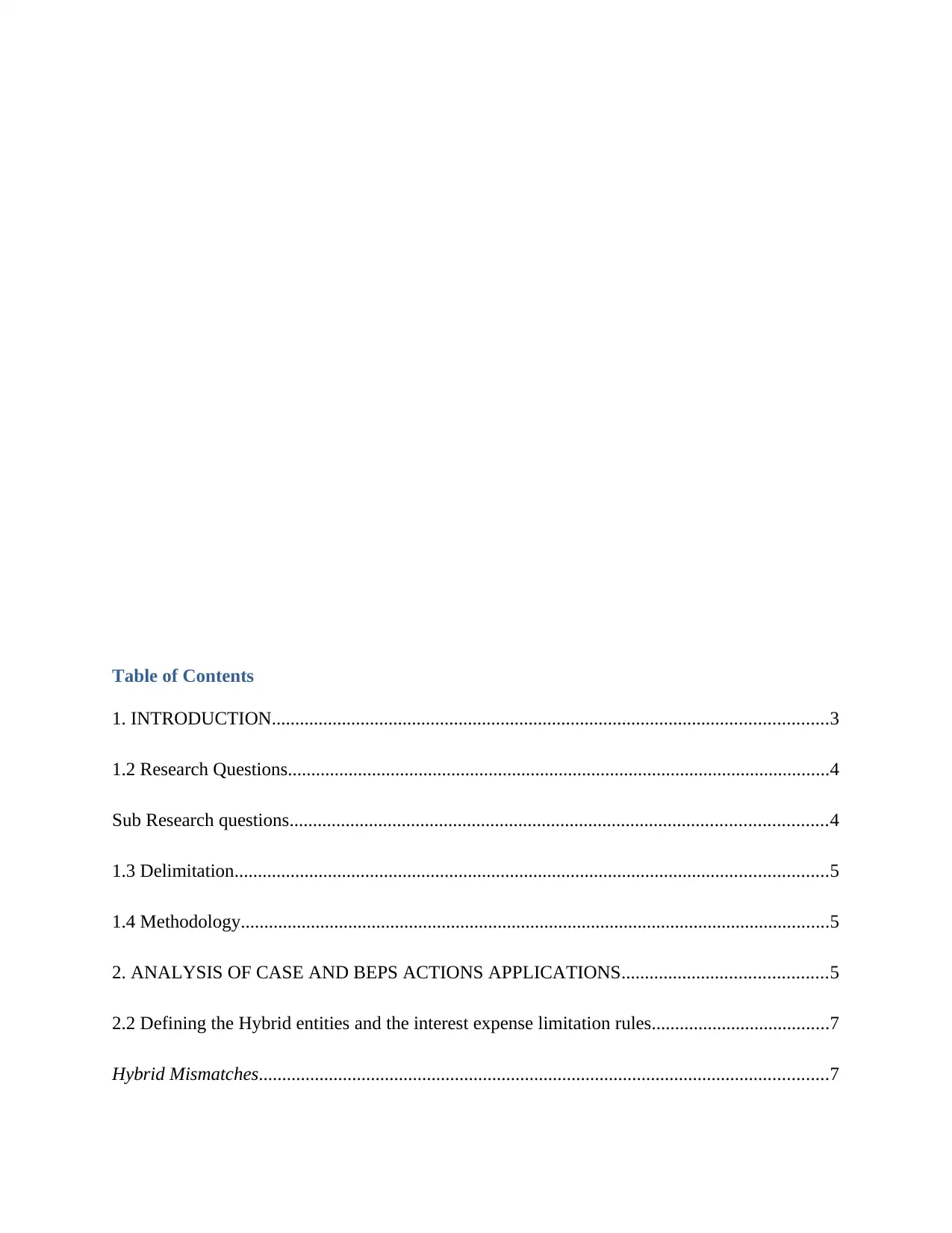
Table of Contents
1. INTRODUCTION.......................................................................................................................3
1.2 Research Questions....................................................................................................................4
Sub Research questions...................................................................................................................4
1.3 Delimitation...............................................................................................................................5
1.4 Methodology..............................................................................................................................5
2. ANALYSIS OF CASE AND BEPS ACTIONS APPLICATIONS............................................5
2.2 Defining the Hybrid entities and the interest expense limitation rules......................................7
Hybrid Mismatches..........................................................................................................................7
1. INTRODUCTION.......................................................................................................................3
1.2 Research Questions....................................................................................................................4
Sub Research questions...................................................................................................................4
1.3 Delimitation...............................................................................................................................5
1.4 Methodology..............................................................................................................................5
2. ANALYSIS OF CASE AND BEPS ACTIONS APPLICATIONS............................................5
2.2 Defining the Hybrid entities and the interest expense limitation rules......................................7
Hybrid Mismatches..........................................................................................................................7
⊘ This is a preview!⊘
Do you want full access?
Subscribe today to unlock all pages.

Trusted by 1+ million students worldwide

Action 2 - Hybrid Mismatch arrangements.....................................................................................8
Action 4 - Limitation over the Interest deductions........................................................................10
Interest limitation rules and the hybrid entities.............................................................................11
Interaction with other anti base erosion rules and regulations......................................................12
Dependency on foreign laws.........................................................................................................12
2.4 Reference to the case law and legislation................................................................................12
CASE – Morrissey vs Commissioner, 296 US 344 (1935).............................................................12
2.5 Effects of the rulings on financial accounts that are based on IFRS.......................................13
2.6 Social impacts of such rulings.................................................................................................14
2.7 Possible amendments or changes in BEP guidelines...............................................................14
3. CONCLUSION.....................................................................................................................15
REFERENCES AND SOURCES OF INFORMATION..............................................................16
1. INTRODUCTION
Action 4 - Limitation over the Interest deductions........................................................................10
Interest limitation rules and the hybrid entities.............................................................................11
Interaction with other anti base erosion rules and regulations......................................................12
Dependency on foreign laws.........................................................................................................12
2.4 Reference to the case law and legislation................................................................................12
CASE – Morrissey vs Commissioner, 296 US 344 (1935).............................................................12
2.5 Effects of the rulings on financial accounts that are based on IFRS.......................................13
2.6 Social impacts of such rulings.................................................................................................14
2.7 Possible amendments or changes in BEP guidelines...............................................................14
3. CONCLUSION.....................................................................................................................15
REFERENCES AND SOURCES OF INFORMATION..............................................................16
1. INTRODUCTION
Paraphrase This Document
Need a fresh take? Get an instant paraphrase of this document with our AI Paraphraser
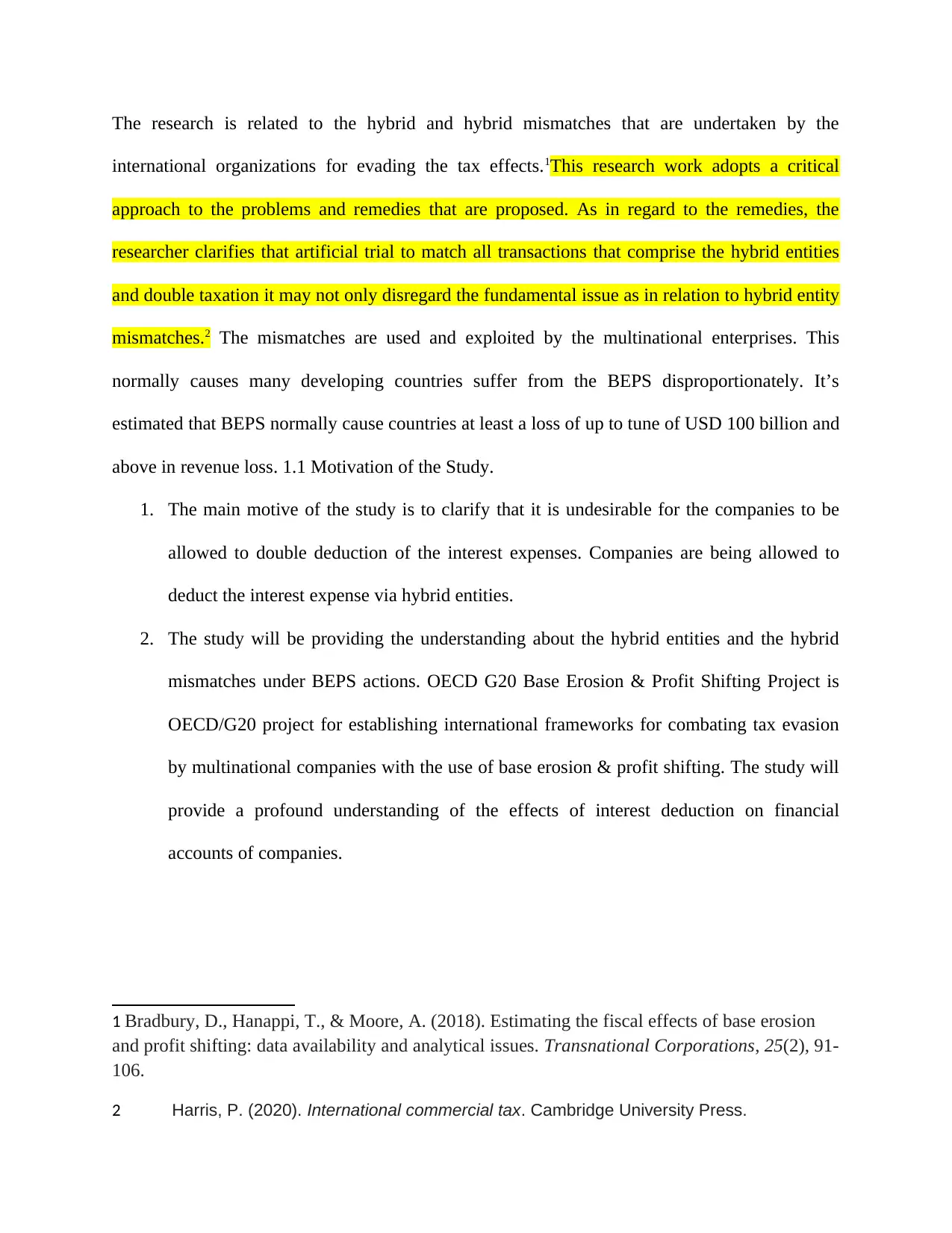
The research is related to the hybrid and hybrid mismatches that are undertaken by the
international organizations for evading the tax effects.1This research work adopts a critical
approach to the problems and remedies that are proposed. As in regard to the remedies, the
researcher clarifies that artificial trial to match all transactions that comprise the hybrid entities
and double taxation it may not only disregard the fundamental issue as in relation to hybrid entity
mismatches.2 The mismatches are used and exploited by the multinational enterprises. This
normally causes many developing countries suffer from the BEPS disproportionately. It’s
estimated that BEPS normally cause countries at least a loss of up to tune of USD 100 billion and
above in revenue loss. 1.1 Motivation of the Study.
1. The main motive of the study is to clarify that it is undesirable for the companies to be
allowed to double deduction of the interest expenses. Companies are being allowed to
deduct the interest expense via hybrid entities.
2. The study will be providing the understanding about the hybrid entities and the hybrid
mismatches under BEPS actions. OECD G20 Base Erosion & Profit Shifting Project is
OECD/G20 project for establishing international frameworks for combating tax evasion
by multinational companies with the use of base erosion & profit shifting. The study will
provide a profound understanding of the effects of interest deduction on financial
accounts of companies.
1 Bradbury, D., Hanappi, T., & Moore, A. (2018). Estimating the fiscal effects of base erosion
and profit shifting: data availability and analytical issues. Transnational Corporations, 25(2), 91-
106.
2 Harris, P. (2020). International commercial tax. Cambridge University Press.
international organizations for evading the tax effects.1This research work adopts a critical
approach to the problems and remedies that are proposed. As in regard to the remedies, the
researcher clarifies that artificial trial to match all transactions that comprise the hybrid entities
and double taxation it may not only disregard the fundamental issue as in relation to hybrid entity
mismatches.2 The mismatches are used and exploited by the multinational enterprises. This
normally causes many developing countries suffer from the BEPS disproportionately. It’s
estimated that BEPS normally cause countries at least a loss of up to tune of USD 100 billion and
above in revenue loss. 1.1 Motivation of the Study.
1. The main motive of the study is to clarify that it is undesirable for the companies to be
allowed to double deduction of the interest expenses. Companies are being allowed to
deduct the interest expense via hybrid entities.
2. The study will be providing the understanding about the hybrid entities and the hybrid
mismatches under BEPS actions. OECD G20 Base Erosion & Profit Shifting Project is
OECD/G20 project for establishing international frameworks for combating tax evasion
by multinational companies with the use of base erosion & profit shifting. The study will
provide a profound understanding of the effects of interest deduction on financial
accounts of companies.
1 Bradbury, D., Hanappi, T., & Moore, A. (2018). Estimating the fiscal effects of base erosion
and profit shifting: data availability and analytical issues. Transnational Corporations, 25(2), 91-
106.
2 Harris, P. (2020). International commercial tax. Cambridge University Press.
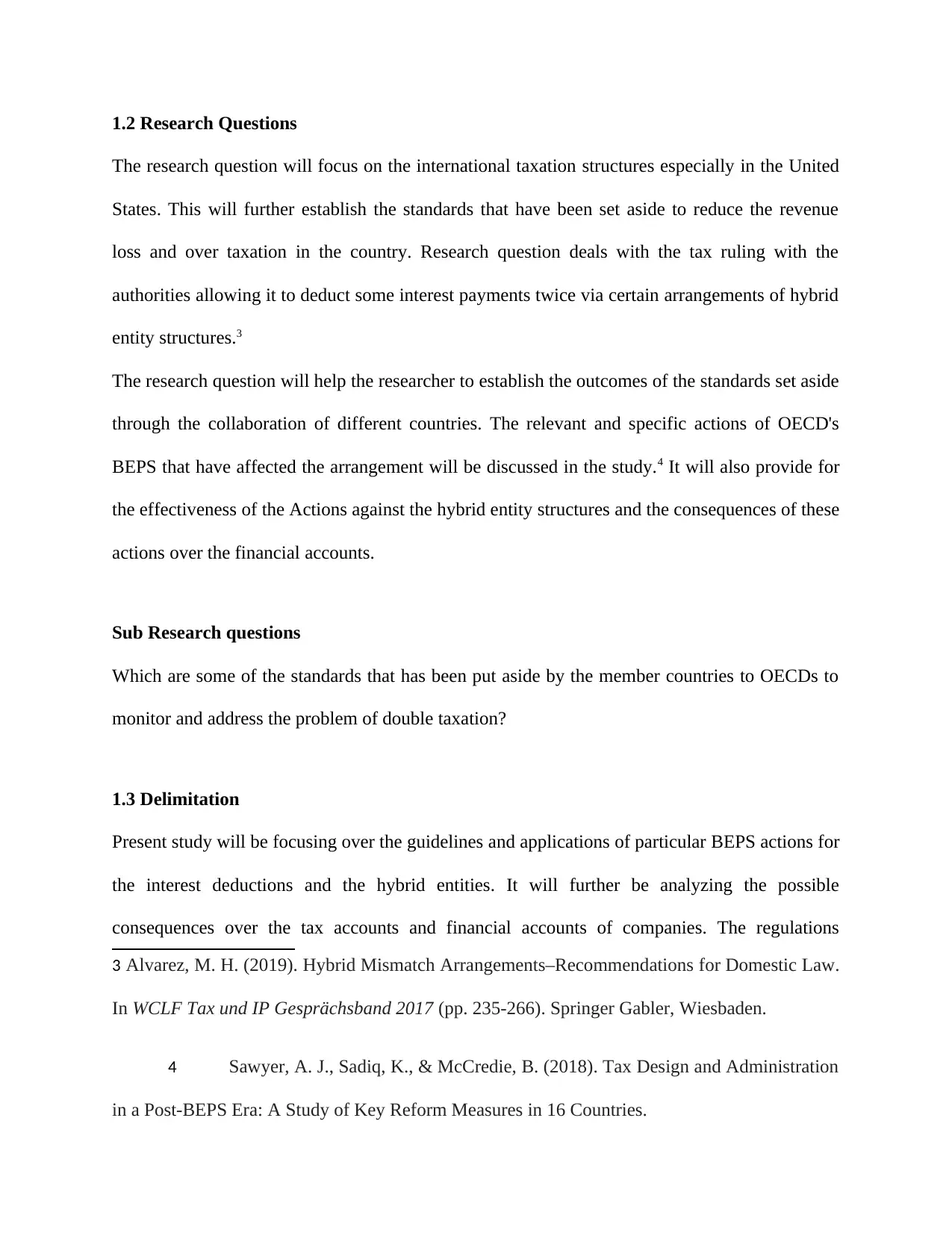
1.2 Research Questions
The research question will focus on the international taxation structures especially in the United
States. This will further establish the standards that have been set aside to reduce the revenue
loss and over taxation in the country. Research question deals with the tax ruling with the
authorities allowing it to deduct some interest payments twice via certain arrangements of hybrid
entity structures.3
The research question will help the researcher to establish the outcomes of the standards set aside
through the collaboration of different countries. The relevant and specific actions of OECD's
BEPS that have affected the arrangement will be discussed in the study.4 It will also provide for
the effectiveness of the Actions against the hybrid entity structures and the consequences of these
actions over the financial accounts.
Sub Research questions
Which are some of the standards that has been put aside by the member countries to OECDs to
monitor and address the problem of double taxation?
1.3 Delimitation
Present study will be focusing over the guidelines and applications of particular BEPS actions for
the interest deductions and the hybrid entities. It will further be analyzing the possible
consequences over the tax accounts and financial accounts of companies. The regulations
3 Alvarez, M. H. (2019). Hybrid Mismatch Arrangements–Recommendations for Domestic Law.
In WCLF Tax und IP Gesprächsband 2017 (pp. 235-266). Springer Gabler, Wiesbaden.
4 Sawyer, A. J., Sadiq, K., & McCredie, B. (2018). Tax Design and Administration
in a Post-BEPS Era: A Study of Key Reform Measures in 16 Countries.
The research question will focus on the international taxation structures especially in the United
States. This will further establish the standards that have been set aside to reduce the revenue
loss and over taxation in the country. Research question deals with the tax ruling with the
authorities allowing it to deduct some interest payments twice via certain arrangements of hybrid
entity structures.3
The research question will help the researcher to establish the outcomes of the standards set aside
through the collaboration of different countries. The relevant and specific actions of OECD's
BEPS that have affected the arrangement will be discussed in the study.4 It will also provide for
the effectiveness of the Actions against the hybrid entity structures and the consequences of these
actions over the financial accounts.
Sub Research questions
Which are some of the standards that has been put aside by the member countries to OECDs to
monitor and address the problem of double taxation?
1.3 Delimitation
Present study will be focusing over the guidelines and applications of particular BEPS actions for
the interest deductions and the hybrid entities. It will further be analyzing the possible
consequences over the tax accounts and financial accounts of companies. The regulations
3 Alvarez, M. H. (2019). Hybrid Mismatch Arrangements–Recommendations for Domestic Law.
In WCLF Tax und IP Gesprächsband 2017 (pp. 235-266). Springer Gabler, Wiesbaden.
4 Sawyer, A. J., Sadiq, K., & McCredie, B. (2018). Tax Design and Administration
in a Post-BEPS Era: A Study of Key Reform Measures in 16 Countries.
⊘ This is a preview!⊘
Do you want full access?
Subscribe today to unlock all pages.

Trusted by 1+ million students worldwide
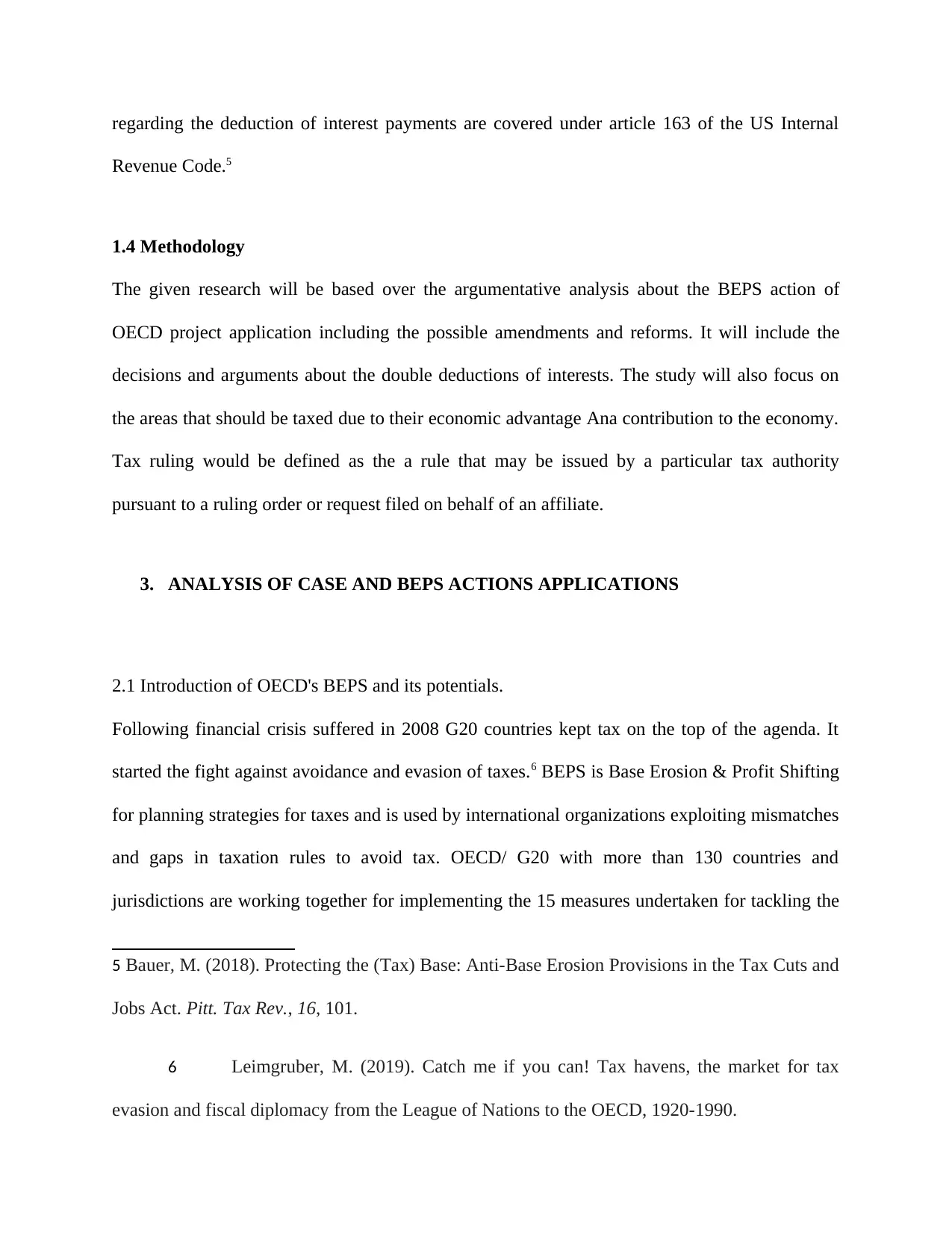
regarding the deduction of interest payments are covered under article 163 of the US Internal
Revenue Code.5
1.4 Methodology
The given research will be based over the argumentative analysis about the BEPS action of
OECD project application including the possible amendments and reforms. It will include the
decisions and arguments about the double deductions of interests. The study will also focus on
the areas that should be taxed due to their economic advantage Ana contribution to the economy.
Tax ruling would be defined as the a rule that may be issued by a particular tax authority
pursuant to a ruling order or request filed on behalf of an affiliate.
3. ANALYSIS OF CASE AND BEPS ACTIONS APPLICATIONS
2.1 Introduction of OECD's BEPS and its potentials.
Following financial crisis suffered in 2008 G20 countries kept tax on the top of the agenda. It
started the fight against avoidance and evasion of taxes.6 BEPS is Base Erosion & Profit Shifting
for planning strategies for taxes and is used by international organizations exploiting mismatches
and gaps in taxation rules to avoid tax. OECD/ G20 with more than 130 countries and
jurisdictions are working together for implementing the 15 measures undertaken for tackling the
5 Bauer, M. (2018). Protecting the (Tax) Base: Anti-Base Erosion Provisions in the Tax Cuts and
Jobs Act. Pitt. Tax Rev., 16, 101.
6 Leimgruber, M. (2019). Catch me if you can! Tax havens, the market for tax
evasion and fiscal diplomacy from the League of Nations to the OECD, 1920-1990.
Revenue Code.5
1.4 Methodology
The given research will be based over the argumentative analysis about the BEPS action of
OECD project application including the possible amendments and reforms. It will include the
decisions and arguments about the double deductions of interests. The study will also focus on
the areas that should be taxed due to their economic advantage Ana contribution to the economy.
Tax ruling would be defined as the a rule that may be issued by a particular tax authority
pursuant to a ruling order or request filed on behalf of an affiliate.
3. ANALYSIS OF CASE AND BEPS ACTIONS APPLICATIONS
2.1 Introduction of OECD's BEPS and its potentials.
Following financial crisis suffered in 2008 G20 countries kept tax on the top of the agenda. It
started the fight against avoidance and evasion of taxes.6 BEPS is Base Erosion & Profit Shifting
for planning strategies for taxes and is used by international organizations exploiting mismatches
and gaps in taxation rules to avoid tax. OECD/ G20 with more than 130 countries and
jurisdictions are working together for implementing the 15 measures undertaken for tackling the
5 Bauer, M. (2018). Protecting the (Tax) Base: Anti-Base Erosion Provisions in the Tax Cuts and
Jobs Act. Pitt. Tax Rev., 16, 101.
6 Leimgruber, M. (2019). Catch me if you can! Tax havens, the market for tax
evasion and fiscal diplomacy from the League of Nations to the OECD, 1920-1990.
Paraphrase This Document
Need a fresh take? Get an instant paraphrase of this document with our AI Paraphraser
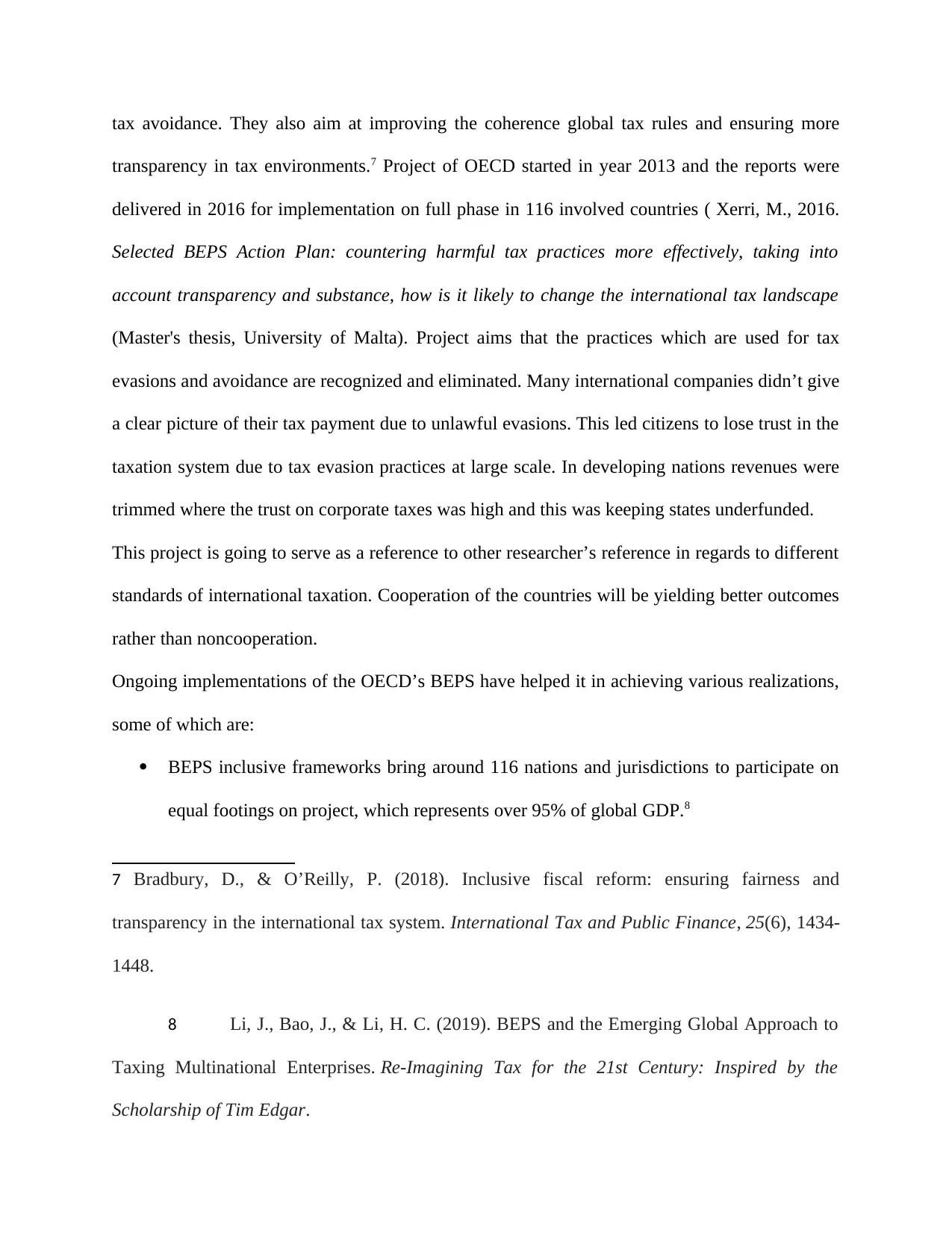
tax avoidance. They also aim at improving the coherence global tax rules and ensuring more
transparency in tax environments.7 Project of OECD started in year 2013 and the reports were
delivered in 2016 for implementation on full phase in 116 involved countries ( Xerri, M., 2016.
Selected BEPS Action Plan: countering harmful tax practices more effectively, taking into
account transparency and substance, how is it likely to change the international tax landscape
(Master's thesis, University of Malta). Project aims that the practices which are used for tax
evasions and avoidance are recognized and eliminated. Many international companies didn’t give
a clear picture of their tax payment due to unlawful evasions. This led citizens to lose trust in the
taxation system due to tax evasion practices at large scale. In developing nations revenues were
trimmed where the trust on corporate taxes was high and this was keeping states underfunded.
This project is going to serve as a reference to other researcher’s reference in regards to different
standards of international taxation. Cooperation of the countries will be yielding better outcomes
rather than noncooperation.
Ongoing implementations of the OECD’s BEPS have helped it in achieving various realizations,
some of which are:
BEPS inclusive frameworks bring around 116 nations and jurisdictions to participate on
equal footings on project, which represents over 95% of global GDP.8
7 Bradbury, D., & O’Reilly, P. (2018). Inclusive fiscal reform: ensuring fairness and
transparency in the international tax system. International Tax and Public Finance, 25(6), 1434-
1448.
8 Li, J., Bao, J., & Li, H. C. (2019). BEPS and the Emerging Global Approach to
Taxing Multinational Enterprises. Re-Imagining Tax for the 21st Century: Inspired by the
Scholarship of Tim Edgar.
transparency in tax environments.7 Project of OECD started in year 2013 and the reports were
delivered in 2016 for implementation on full phase in 116 involved countries ( Xerri, M., 2016.
Selected BEPS Action Plan: countering harmful tax practices more effectively, taking into
account transparency and substance, how is it likely to change the international tax landscape
(Master's thesis, University of Malta). Project aims that the practices which are used for tax
evasions and avoidance are recognized and eliminated. Many international companies didn’t give
a clear picture of their tax payment due to unlawful evasions. This led citizens to lose trust in the
taxation system due to tax evasion practices at large scale. In developing nations revenues were
trimmed where the trust on corporate taxes was high and this was keeping states underfunded.
This project is going to serve as a reference to other researcher’s reference in regards to different
standards of international taxation. Cooperation of the countries will be yielding better outcomes
rather than noncooperation.
Ongoing implementations of the OECD’s BEPS have helped it in achieving various realizations,
some of which are:
BEPS inclusive frameworks bring around 116 nations and jurisdictions to participate on
equal footings on project, which represents over 95% of global GDP.8
7 Bradbury, D., & O’Reilly, P. (2018). Inclusive fiscal reform: ensuring fairness and
transparency in the international tax system. International Tax and Public Finance, 25(6), 1434-
1448.
8 Li, J., Bao, J., & Li, H. C. (2019). BEPS and the Emerging Global Approach to
Taxing Multinational Enterprises. Re-Imagining Tax for the 21st Century: Inspired by the
Scholarship of Tim Edgar.
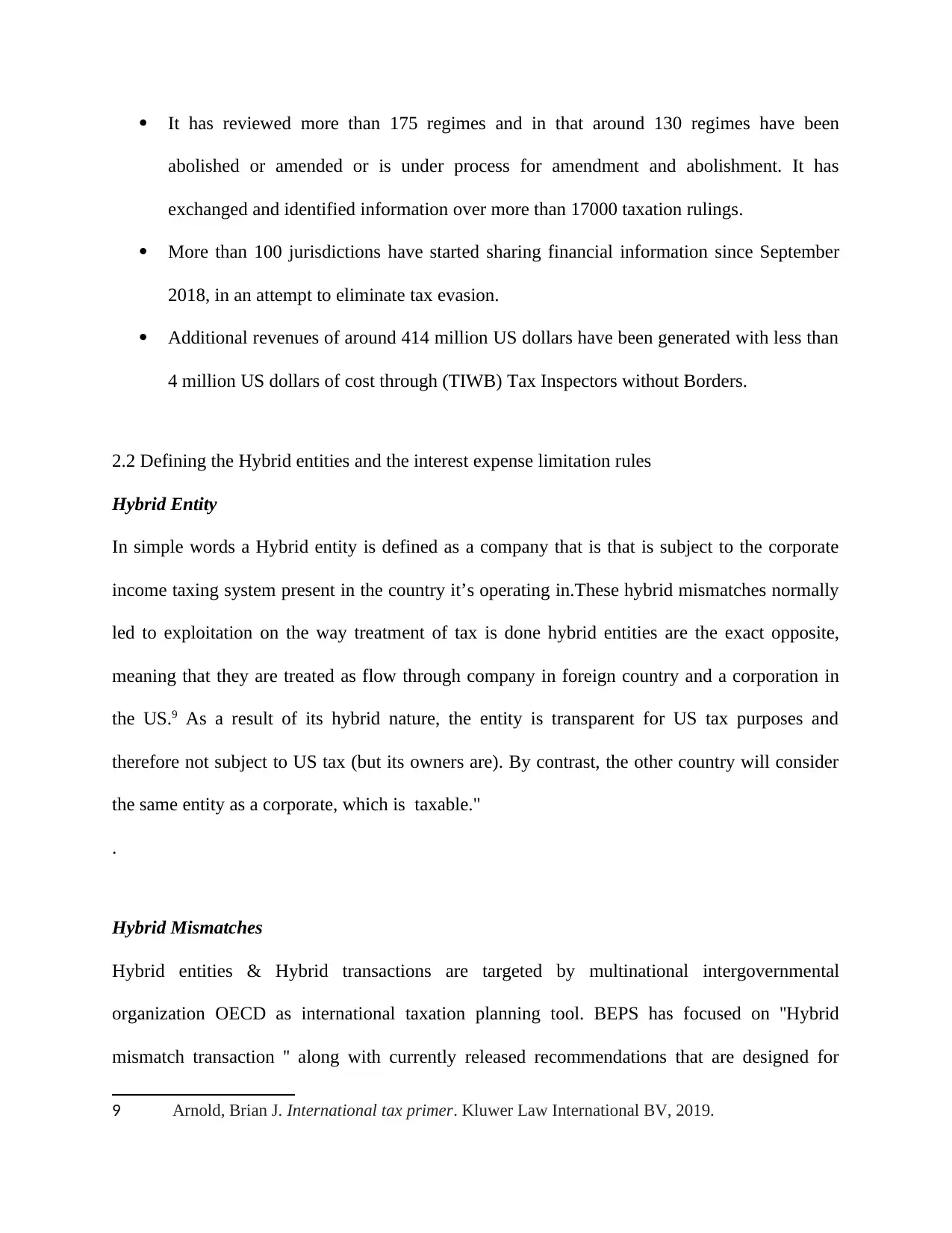
It has reviewed more than 175 regimes and in that around 130 regimes have been
abolished or amended or is under process for amendment and abolishment. It has
exchanged and identified information over more than 17000 taxation rulings.
More than 100 jurisdictions have started sharing financial information since September
2018, in an attempt to eliminate tax evasion.
Additional revenues of around 414 million US dollars have been generated with less than
4 million US dollars of cost through (TIWB) Tax Inspectors without Borders.
2.2 Defining the Hybrid entities and the interest expense limitation rules
Hybrid Entity
In simple words a Hybrid entity is defined as a company that is that is subject to the corporate
income taxing system present in the country it’s operating in.These hybrid mismatches normally
led to exploitation on the way treatment of tax is done hybrid entities are the exact opposite,
meaning that they are treated as flow through company in foreign country and a corporation in
the US.9 As a result of its hybrid nature, the entity is transparent for US tax purposes and
therefore not subject to US tax (but its owners are). By contrast, the other country will consider
the same entity as a corporate, which is taxable."
.
Hybrid Mismatches
Hybrid entities & Hybrid transactions are targeted by multinational intergovernmental
organization OECD as international taxation planning tool. BEPS has focused on ''Hybrid
mismatch transaction '' along with currently released recommendations that are designed for
9 Arnold, Brian J. International tax primer. Kluwer Law International BV, 2019.
abolished or amended or is under process for amendment and abolishment. It has
exchanged and identified information over more than 17000 taxation rulings.
More than 100 jurisdictions have started sharing financial information since September
2018, in an attempt to eliminate tax evasion.
Additional revenues of around 414 million US dollars have been generated with less than
4 million US dollars of cost through (TIWB) Tax Inspectors without Borders.
2.2 Defining the Hybrid entities and the interest expense limitation rules
Hybrid Entity
In simple words a Hybrid entity is defined as a company that is that is subject to the corporate
income taxing system present in the country it’s operating in.These hybrid mismatches normally
led to exploitation on the way treatment of tax is done hybrid entities are the exact opposite,
meaning that they are treated as flow through company in foreign country and a corporation in
the US.9 As a result of its hybrid nature, the entity is transparent for US tax purposes and
therefore not subject to US tax (but its owners are). By contrast, the other country will consider
the same entity as a corporate, which is taxable."
.
Hybrid Mismatches
Hybrid entities & Hybrid transactions are targeted by multinational intergovernmental
organization OECD as international taxation planning tool. BEPS has focused on ''Hybrid
mismatch transaction '' along with currently released recommendations that are designed for
9 Arnold, Brian J. International tax primer. Kluwer Law International BV, 2019.
⊘ This is a preview!⊘
Do you want full access?
Subscribe today to unlock all pages.

Trusted by 1+ million students worldwide
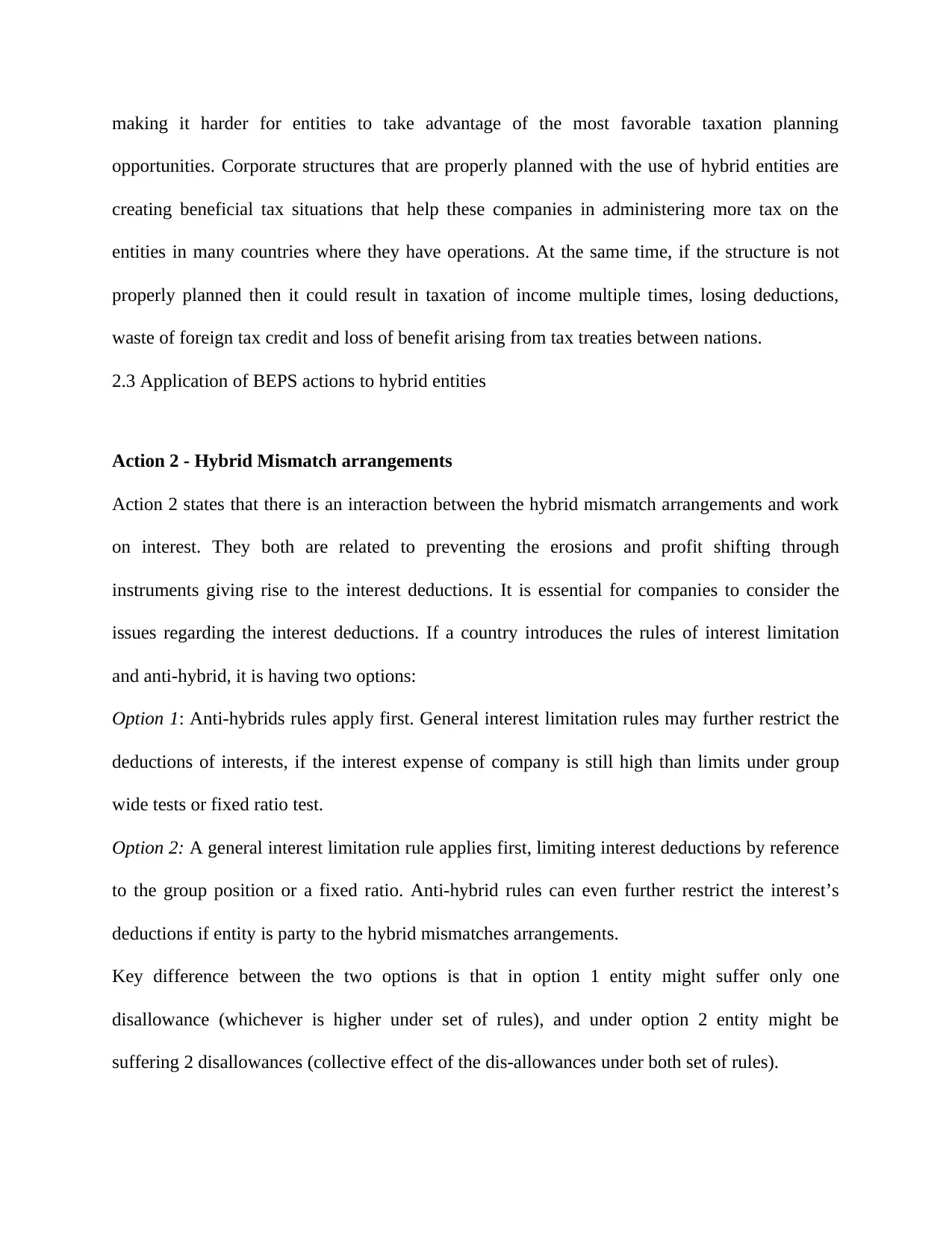
making it harder for entities to take advantage of the most favorable taxation planning
opportunities. Corporate structures that are properly planned with the use of hybrid entities are
creating beneficial tax situations that help these companies in administering more tax on the
entities in many countries where they have operations. At the same time, if the structure is not
properly planned then it could result in taxation of income multiple times, losing deductions,
waste of foreign tax credit and loss of benefit arising from tax treaties between nations.
2.3 Application of BEPS actions to hybrid entities
Action 2 - Hybrid Mismatch arrangements
Action 2 states that there is an interaction between the hybrid mismatch arrangements and work
on interest. They both are related to preventing the erosions and profit shifting through
instruments giving rise to the interest deductions. It is essential for companies to consider the
issues regarding the interest deductions. If a country introduces the rules of interest limitation
and anti-hybrid, it is having two options:
Option 1: Anti-hybrids rules apply first. General interest limitation rules may further restrict the
deductions of interests, if the interest expense of company is still high than limits under group
wide tests or fixed ratio test.
Option 2: A general interest limitation rule applies first, limiting interest deductions by reference
to the group position or a fixed ratio. Anti-hybrid rules can even further restrict the interest’s
deductions if entity is party to the hybrid mismatches arrangements.
Key difference between the two options is that in option 1 entity might suffer only one
disallowance (whichever is higher under set of rules), and under option 2 entity might be
suffering 2 disallowances (collective effect of the dis-allowances under both set of rules).
opportunities. Corporate structures that are properly planned with the use of hybrid entities are
creating beneficial tax situations that help these companies in administering more tax on the
entities in many countries where they have operations. At the same time, if the structure is not
properly planned then it could result in taxation of income multiple times, losing deductions,
waste of foreign tax credit and loss of benefit arising from tax treaties between nations.
2.3 Application of BEPS actions to hybrid entities
Action 2 - Hybrid Mismatch arrangements
Action 2 states that there is an interaction between the hybrid mismatch arrangements and work
on interest. They both are related to preventing the erosions and profit shifting through
instruments giving rise to the interest deductions. It is essential for companies to consider the
issues regarding the interest deductions. If a country introduces the rules of interest limitation
and anti-hybrid, it is having two options:
Option 1: Anti-hybrids rules apply first. General interest limitation rules may further restrict the
deductions of interests, if the interest expense of company is still high than limits under group
wide tests or fixed ratio test.
Option 2: A general interest limitation rule applies first, limiting interest deductions by reference
to the group position or a fixed ratio. Anti-hybrid rules can even further restrict the interest’s
deductions if entity is party to the hybrid mismatches arrangements.
Key difference between the two options is that in option 1 entity might suffer only one
disallowance (whichever is higher under set of rules), and under option 2 entity might be
suffering 2 disallowances (collective effect of the dis-allowances under both set of rules).
Paraphrase This Document
Need a fresh take? Get an instant paraphrase of this document with our AI Paraphraser
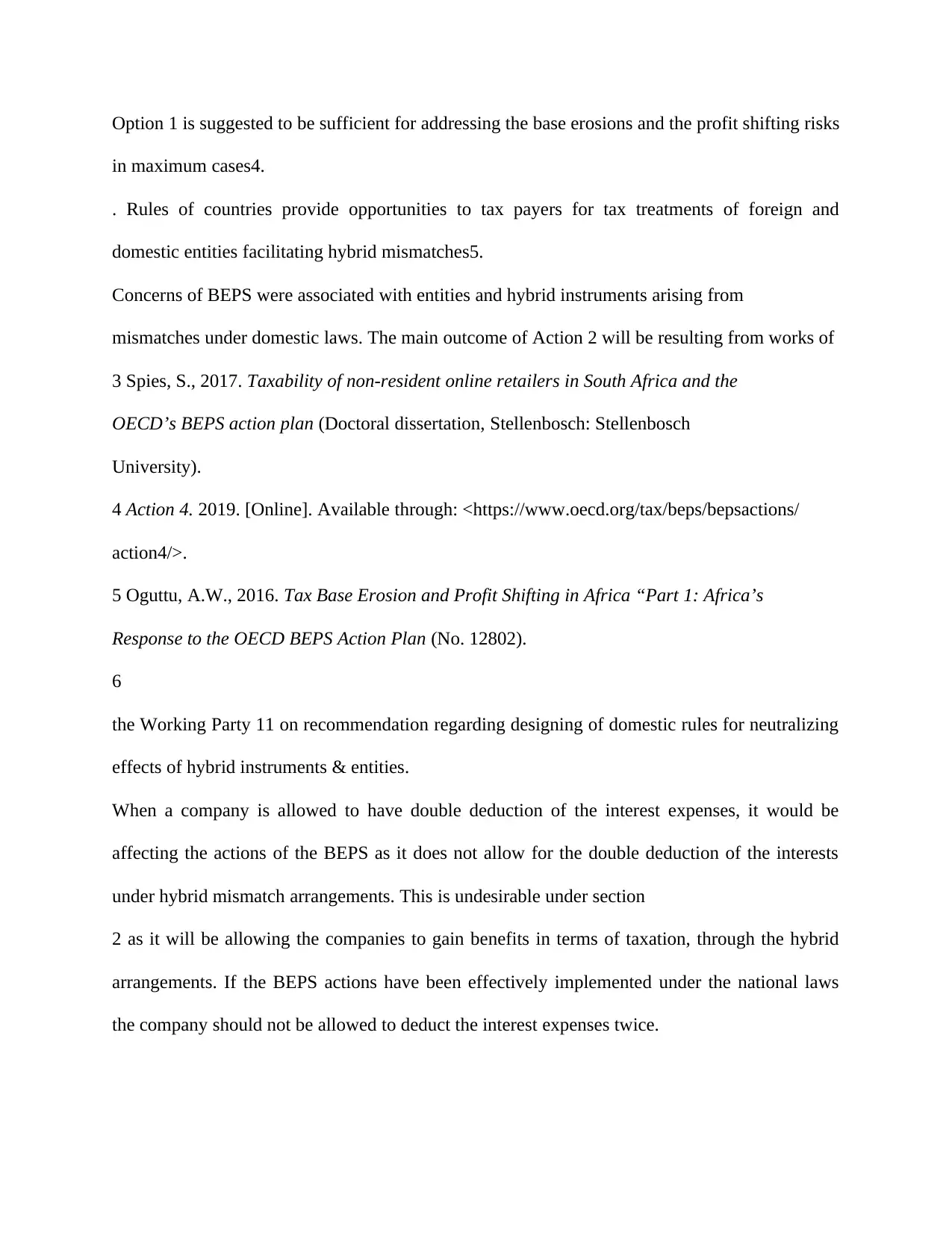
Option 1 is suggested to be sufficient for addressing the base erosions and the profit shifting risks
in maximum cases4.
. Rules of countries provide opportunities to tax payers for tax treatments of foreign and
domestic entities facilitating hybrid mismatches5.
Concerns of BEPS were associated with entities and hybrid instruments arising from
mismatches under domestic laws. The main outcome of Action 2 will be resulting from works of
3 Spies, S., 2017. Taxability of non-resident online retailers in South Africa and the
OECD’s BEPS action plan (Doctoral dissertation, Stellenbosch: Stellenbosch
University).
4 Action 4. 2019. [Online]. Available through: <https://www.oecd.org/tax/beps/bepsactions/
action4/>.
5 Oguttu, A.W., 2016. Tax Base Erosion and Profit Shifting in Africa “Part 1: Africa’s
Response to the OECD BEPS Action Plan (No. 12802).
6
the Working Party 11 on recommendation regarding designing of domestic rules for neutralizing
effects of hybrid instruments & entities.
When a company is allowed to have double deduction of the interest expenses, it would be
affecting the actions of the BEPS as it does not allow for the double deduction of the interests
under hybrid mismatch arrangements. This is undesirable under section
2 as it will be allowing the companies to gain benefits in terms of taxation, through the hybrid
arrangements. If the BEPS actions have been effectively implemented under the national laws
the company should not be allowed to deduct the interest expenses twice.
in maximum cases4.
. Rules of countries provide opportunities to tax payers for tax treatments of foreign and
domestic entities facilitating hybrid mismatches5.
Concerns of BEPS were associated with entities and hybrid instruments arising from
mismatches under domestic laws. The main outcome of Action 2 will be resulting from works of
3 Spies, S., 2017. Taxability of non-resident online retailers in South Africa and the
OECD’s BEPS action plan (Doctoral dissertation, Stellenbosch: Stellenbosch
University).
4 Action 4. 2019. [Online]. Available through: <https://www.oecd.org/tax/beps/bepsactions/
action4/>.
5 Oguttu, A.W., 2016. Tax Base Erosion and Profit Shifting in Africa “Part 1: Africa’s
Response to the OECD BEPS Action Plan (No. 12802).
6
the Working Party 11 on recommendation regarding designing of domestic rules for neutralizing
effects of hybrid instruments & entities.
When a company is allowed to have double deduction of the interest expenses, it would be
affecting the actions of the BEPS as it does not allow for the double deduction of the interests
under hybrid mismatch arrangements. This is undesirable under section
2 as it will be allowing the companies to gain benefits in terms of taxation, through the hybrid
arrangements. If the BEPS actions have been effectively implemented under the national laws
the company should not be allowed to deduct the interest expenses twice.
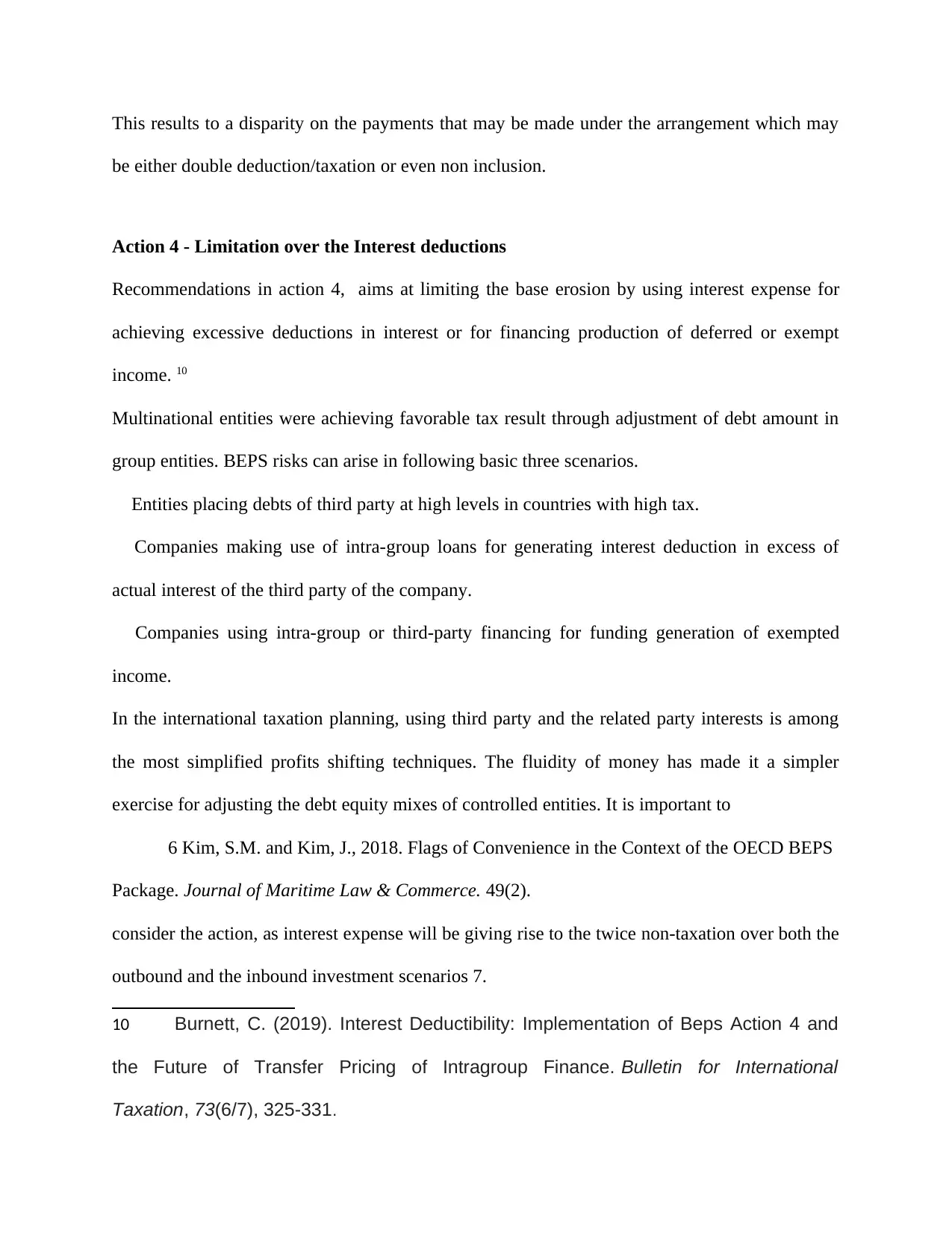
This results to a disparity on the payments that may be made under the arrangement which may
be either double deduction/taxation or even non inclusion.
Action 4 - Limitation over the Interest deductions
Recommendations in action 4, aims at limiting the base erosion by using interest expense for
achieving excessive deductions in interest or for financing production of deferred or exempt
income. 10
Multinational entities were achieving favorable tax result through adjustment of debt amount in
group entities. BEPS risks can arise in following basic three scenarios.
Entities placing debts of third party at high levels in countries with high tax.
Companies making use of intra-group loans for generating interest deduction in excess of
actual interest of the third party of the company.
Companies using intra-group or third-party financing for funding generation of exempted
income.
In the international taxation planning, using third party and the related party interests is among
the most simplified profits shifting techniques. The fluidity of money has made it a simpler
exercise for adjusting the debt equity mixes of controlled entities. It is important to
6 Kim, S.M. and Kim, J., 2018. Flags of Convenience in the Context of the OECD BEPS
Package. Journal of Maritime Law & Commerce. 49(2).
consider the action, as interest expense will be giving rise to the twice non-taxation over both the
outbound and the inbound investment scenarios 7.
10 Burnett, C. (2019). Interest Deductibility: Implementation of Beps Action 4 and
the Future of Transfer Pricing of Intragroup Finance. Bulletin for International
Taxation, 73(6/7), 325-331.
be either double deduction/taxation or even non inclusion.
Action 4 - Limitation over the Interest deductions
Recommendations in action 4, aims at limiting the base erosion by using interest expense for
achieving excessive deductions in interest or for financing production of deferred or exempt
income. 10
Multinational entities were achieving favorable tax result through adjustment of debt amount in
group entities. BEPS risks can arise in following basic three scenarios.
Entities placing debts of third party at high levels in countries with high tax.
Companies making use of intra-group loans for generating interest deduction in excess of
actual interest of the third party of the company.
Companies using intra-group or third-party financing for funding generation of exempted
income.
In the international taxation planning, using third party and the related party interests is among
the most simplified profits shifting techniques. The fluidity of money has made it a simpler
exercise for adjusting the debt equity mixes of controlled entities. It is important to
6 Kim, S.M. and Kim, J., 2018. Flags of Convenience in the Context of the OECD BEPS
Package. Journal of Maritime Law & Commerce. 49(2).
consider the action, as interest expense will be giving rise to the twice non-taxation over both the
outbound and the inbound investment scenarios 7.
10 Burnett, C. (2019). Interest Deductibility: Implementation of Beps Action 4 and
the Future of Transfer Pricing of Intragroup Finance. Bulletin for International
Taxation, 73(6/7), 325-331.
⊘ This is a preview!⊘
Do you want full access?
Subscribe today to unlock all pages.

Trusted by 1+ million students worldwide
1 out of 18
Your All-in-One AI-Powered Toolkit for Academic Success.
+13062052269
info@desklib.com
Available 24*7 on WhatsApp / Email
![[object Object]](/_next/static/media/star-bottom.7253800d.svg)
Unlock your academic potential
Copyright © 2020–2025 A2Z Services. All Rights Reserved. Developed and managed by ZUCOL.


